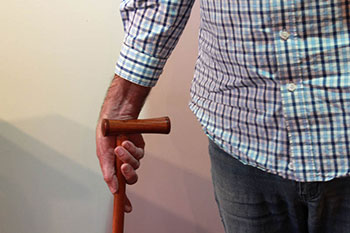How to Use a Walking Stick
We have been selling our wooden walking sticks for many years during which time they have remained one of our most popular items because of their strong construction using sturdy spigot joints, their choice of handle - T-bar or knob - and of course the range of beautiful native timbers used in their making.
Greg recently had an ankle reconstruction and had to use a walking stick during his recuperation. We discovered that there is quite a protocol to using a walking stick correctly and some aspects are counter intuitive at first, mainly that the stick is used on the side of the good leg not the bad leg which you could be forgiven for thinking is around the wrong way. Use the stick on the injured side right? To take the weight off it – wrong. Apparently it doesn’t work like that. So following are the main points to remember for the correct use of a walking stick.
Firstly, get the height right.
When you are standing up straight, the top of the stick’s handle should reach the crease in your wrist. Our walking sticks will generally be too long and you will need to adjust them. Remove the rubber tip and using a hacksaw trim the bottom of the stick – we recommend doing this in increments to ensure not too much is taken off, noting the old carpentry proverb ‘measure twice, cut once’. Your stick should be comfortable and not push your shoulder up and your elbow should be slightly bent when you hold it.
Walking.
Hold the stick in the hand opposite the side that needs support. If your right knee is injured for example, hold the stick in your left hand.
To start walking, place your stick one small step ahead and slightly to the side of you (so you don’t kick it) and step off on your injured leg, finishing the step with your good leg.
Stairs.
Stairs can be tricky but put simply, go up with the good, down with the bad. To go up stairs hold your stick in the hand opposite your weak leg, the other hand holds the rail. Put the good leg on the stair first, followed by the cane then lastly the weak leg. To go down stairs, put the cane on the stair first, then the weak leg, then lastly the good leg. To summarise:
Going up stairs - good leg, stick, weak leg
Going down stairs - stick, weak leg, strong leg.
If you are thinking of investing in a well made, unique, wooden walking stick then we hope you have found this article helpful and informative.
Click here to view our range of Australian Handmade Walking Sticks >>













Dear Dr Jo.
I fractured my tibeal plateau and was unable to weight bare (right leg) for 6 weeks.
Now I can put maximum weight on my previously injured right leg.
So does it matter which side I hold the cane? Can I hold he can on either side as I start to use a walking cane?
Thanks for any advice.
Ray
Thank you for a wonderful site that will help us with our 90 yo mother in learning to use a stick.